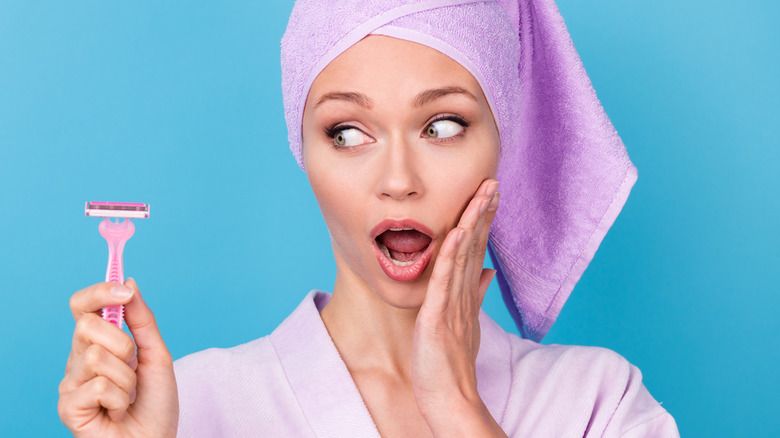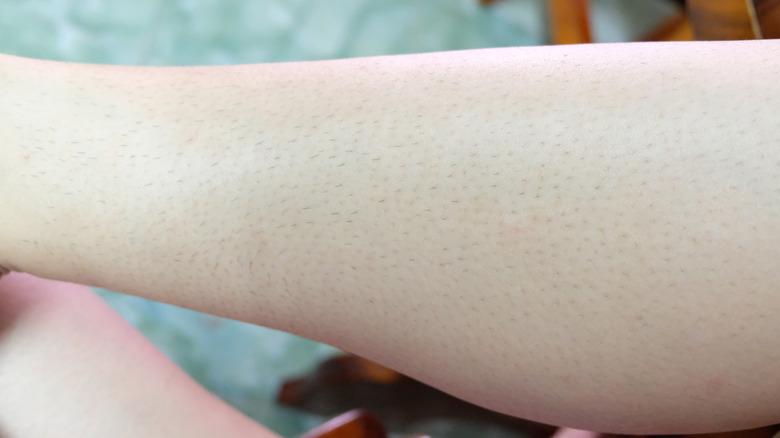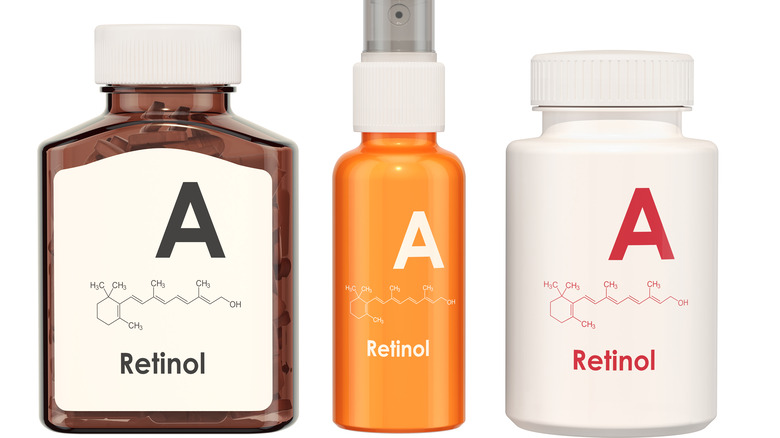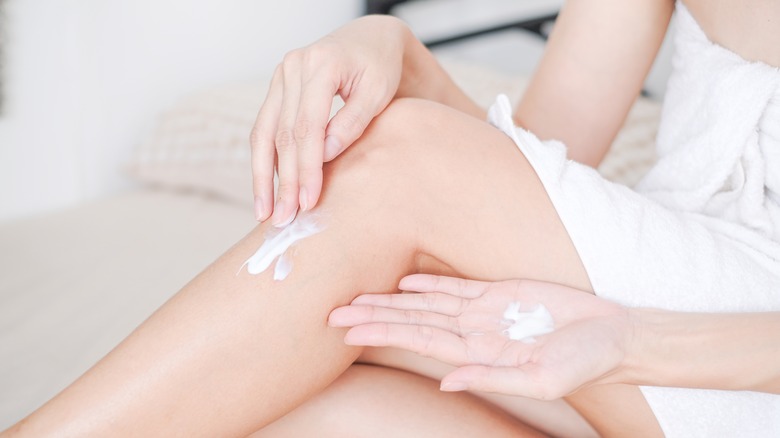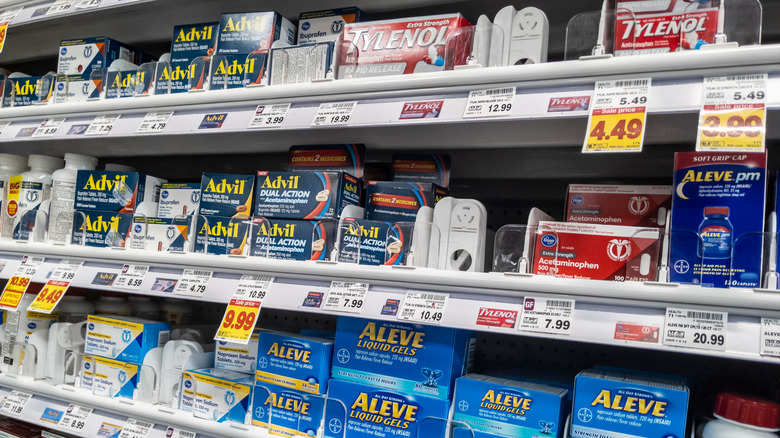Tips For Making The Swap From Shaving To Waxing
If you've been dedicated to your razor since you began shaving, you might feel like a bit of a traitor for thinking about potentially turning to waxing for hair removal. However, there are some benefits you might be unaware of that are associated with waxing over shaving.
For starters, waxing often lasts longer than shaving in terms of hair regrowth. While shaving might only give you smooth skin for a few days, waxing can keep you hair-free for weeks at a time. This might be especially of interest to you if you regrow hair quickly, or you simply don't have the time to keep up with shaving. The Cleveland Clinic also notes that waxing can exfoliate your skin. Exfoliation can unclog your pores, preventing acne, and even out your skin tone by removing dead skin cells.
That being said, there are many aspects of waxing that scare people away and convince them to stick to their razors. The pain associated with the process, for example, is one valid reason some have for steering clear of waxing. Waxing can also sometimes result in inflamed hair follicles, skin irritation, or worse — ingrown hairs. These can be particularly tricky and painful to remove. If you're ready to make the swap from shaving to waxing after weighing the pros and cons, here are some key tips that can help.
Let your hair grow out first
It's important to keep in mind that in order for waxing to go as smoothly as possible, you'll want to give your aesthetician (or yourself, if you're doing it at home) a decent amount of hair to remove. While it might sound contradictory, you should hold off on waxing until your hair is at least half an inch in length. If you dislike the feeling of stubble, you might be in for a brief period of irritation while you wait for your hair to grow out.
However, there is an actual reason why waxing professionals require ample growth before waxing. Unlike shaving, waxing removes your hair from the follicle within your skin, as explained by Le Salon. Although using a razor is quick and efficient for hair removal, it's a surface-level approach — literally. By giving yourself or your aesthetician at least half an inch of hair to work with, the wax will have enough to grip onto when the time comes. Longer hair can also potentially lessen the pain associated with the waxing process.
If you're unsure of whether or not your hair is long enough to be waxed, wait at least two weeks — the longer, the better. Don't be afraid to reach out to an expert prior to your waxing session if you want to feel more confident about it. An aesthetician, for instance, can let you know if more growth is necessary.
Avoid using retinoid and retinol products before waxing
Many people don't think of it when they're focused on hair removal, but the skin products they use might be setting them up for pain post-waxing. Retinoid and retinol products, for example, should not be used prior to waxing, according to the American Academy of Dermatology Association (AAD). These popular skincare ingredients are renowned for their exfoliation, but this is what also makes them potentially damaging if you use them before waxing. Because waxing itself is a form of exfoliation, you could go overboard by using a retinol or retinoid product beforehand. Bare Necessities notes that this will likely manifest as redness and irritation that looks like a burn. Those who are new to waxing might even assume that they were burned by their wax when, in fact, the underlying cause was their skincare product use.
As a rule of thumb, stop using your retinol and retinoid products a few days before you wax — a full week is ideal. Generally speaking, exfoliation should be avoided before you wax, as the process will already be removing dead skin cells. After you wax, consider applying moisturizer when you return to using your retinol or retinoid products. This can help your skin heal and stay hydrated. Once you're hairless and silky smooth, give it at least 24 hours before you go back to retinoid or retinol on your skin. Contact your dermatologist if you have any questions about waxing and retinol or retinoid usage.
Make sure your skin is hydrated before waxing
If you're a skincare guru, moisturizing is something you already know all about, but don't underestimate it if you're switching from shaving to waxing. By ensuring that your skin is hydrated before waxing, Le Salon notes that the wax will settle on the area more easily — but avoid heavy moisturizing before the actual process. Lotions and creams can prevent the wax from grasping your hair, resulting in lackluster hair removal results.
Whether you've always naturally experienced dry skin or it's a seasonal issue, there are a few ways you can keep it hydrated. First, make it a point to avoid bathing in hot water — this is a surefire way to dry out even the most hydrated skin. Warm water should always be used, whether you're showering or taking a bath. Next, make it a point to use moisturize your skin right after it's been dried. Lotion may do the trick, but the AAD notes that ointments and creams can be more effective. Some ingredients to seek out include jojoba oil, hyaluronic acid, lactic acid, and shea butter, all of which are known for their moisturizing properties. Try to avoid products that include fragrances or alcohol, which can be potentially irritating to your skin. Finally, do your best to keep moisture in the air at home. A humidifier can do wonders in this respect, especially in cold weather. Just remember to clean it regularly.
Discuss taking a pain-reducing medicine with your doctor
Whether you're waxing for the first time or you haven't done it in a while, you might already be cringing at the thought of the pain. The pain associated with waxing is a real concern for those with a low pain threshold, but there are some measures you can take to limit it. It's not uncommon for those who wax to take an over-the-counter pain medication before the process. However, it's important to speak to your doctor before taking any medicine to mitigate pain, especially if you're already on other medications. They'll be able to guide you toward a safe option and inform you of the best dose for you.
Once you've finished waxing, you might also want to apply an ice pack to the area for additional soothing. Ice can also limit inflammation where the waxing occurred. If you experience pain, redness, or inflammation more than two days post-waxing, the AAD recommends seeing a board-certified dermatologist. While some inflammation is to be expected, a professional can determine if you're dealing with a different issue, such as a burn or an infection. Medical care might also be necessary if you require a prescription for treatment.
Educate yourself on post-waxing aftercare
Even if you're unsure of whether you want to stick with waxing for hair removal after ditching your razor, aftercare is important for both your skin and hair. After your wax, keep in mind that your skin is going to be very sensitive. For this reason, it's a good idea to steer clear of skincare products that include fragrances or dyes that may cause irritation.
Further skin irritation might arise if you bathe, rather than shower, after your waxing. Bathing afterward can even make you susceptible to infection, per The Waxing Co. In general, try to avoid submerging your newly waxed skin in water for prolonged periods for a few days. Bathing in cool or lukewarm water can also help your pores close and stay protected.
Finally, perhaps the best part of post-waxing aftercare is wearing loose-fitted clothing. By avoiding clothes that rub up against your sensitive skin, you can keep yourself comfortable and prevent issues, such as chaffing and irritation. Doing so can also support your skin's healing process and help you stop ingrown hairs from developing. Bust out your sweats, kick back, and relax, as anyone who's undergone waxing will tell you that it's no cakewalk. Once it's over, though, you're entitled to take all the time you need to self-soothe and enjoy your smooth, hairless skin.
